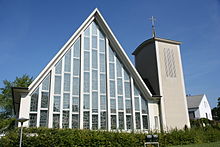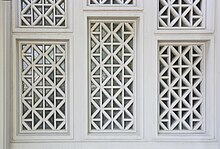St. Marien (Herrliberg)
The Church of St. Mary is the Roman Catholic parish of Herrliberg at the bottom right bank of Lake Zurich in the district of Meilen in the canton of Zurich .
history
History and naming
In the Middle Ages there is evidence of a church of St. Theodoricus and Erhard in Herrliberg and a St. Bartholomew's chapel in the hamlet of Wetzwil . Both were branch churches of the Johanniter parish in Küsnacht ZH . The church of St. Theodoricus and Erhard was first mentioned in 1370 and was built on the rock near Rossbach in the 14th century. Around 1500 this church was expanded and a tower was added. After 1667 this church was demolished and replaced by today's Reformed Church of Herrliberg. Since the Reformation in Zurich from 1523, Catholic worship was banned in Zurich and its subject areas for almost 300 years, until the Edict of Tolerance of the Zurich Government Council of September 10, 1807 allowed a Catholic community in Zurich for the first time.
Until the beginning of the 19th century, Herrliberg was a quiet village. The legal equality of the rural and urban population in the canton of Zurich and the introduction of the freedom of establishment after the establishment of the federal state in 1848 resulted in an initial economic boom in Herrliberg. The construction of new streets and the opening of the right bank of the Zürichseebahn in 1894 made Herrliberg a preferred residential area for wealthy people in Zurich. As part of all these developments, the first Catholics again moved to Herrliberg in the 19th century.
Development and construction history
The Catholic parish of Herrliberg is a branch of the parish of St. Georg Küsnacht . In the first half of the 20th century, the Catholics of Herrliberg wanted their own church. Finding a suitable building site, however, turned out to be difficult. The planned locations in Grüt and Habüel had to be discarded until the building site of today's church could finally be found in Humiges . Since the Catholic Church in the canton of Zurich was only recognized under public law in 1963, the church in Herrliberg had to be built from donations and donations. The architects Ferdinand Pfammatter and Walter Rieger , who jointly built eleven Catholic churches between 1949 and 1966, could be won over to build the church . In 1956 the Herrliberg Church was built and the associated Catholic parish was raised to the parish rectorate. On October 7th, the Bishop of Chur , Christian Caminada , consecrated the church in honor of Our Lady of the Assumption . In the following years, the initially only functional equipment was gradually added. In 1963 Herrliberg was made an independent parish and separated from Küsnacht. In 1972 the parish hall under the church was expanded, in 1976 the church received its bells, in 1985 the church was renovated and in 1986 the church received its present organ. In 2005 the hall was redesigned and in 2015 the interior of the church was gently renovated.
The parish of St. Marien with its 1,608 members (as of 2017) is one of the smaller Catholic parishes in the canton of Zurich.
Building description
Church tower and exterior
Like the churches of Maria Frieden (Dübendorf) , St. Konrad Albisrieden , St. Gallus Schwamendingen and the Eglise Sainte Famille Hottingen, which were also built by Rieger and Pfammatter in the vicinity of Herrliberg, they are built with stylistic references to the French concrete architecture been. Due to the rhythmic concrete pillars and concrete belts, the large church windows and the decorative concrete latticework, these churches by Pfammatter and Rieger belong to the concrete Gothic. The parish hall is located in the basement of the church. The church of St. Marien Herrliberg has a bell tower attached to the church, which, however, does not tower above the gable of the church. The four-part chime was cast by the H. Rüetschi bell foundry in 1976 and sounds in the tone sequence d, f sharp, a, b.
Interior and artistic equipment
Under a vestibule and the church portal you get to the east-facing church. The church interior is characterized by the gable roof that extends far down. As in the St. Gallus Church in Zurich-Schwamendingen, the two large windows that occupy the east and west fronts of the church are decisive for the entire church building. While the west window is characterized by the tracery elements of the concrete Gothic, the east window consists of a monumental glass window that Hans Stocker , Basel, created in 1961. In keeping with the Marian patronage of the church, the lower part of the glass window is kept in shades of blue. The blue is broken up by yellow and red areas in which Jesus and Mary are depicted. In the middle of the glass painting, above the altar , Mary is depicted under the cross of Christ. In the upper area of the glass window, the sun and moon as well as the Assumption of Mary can be seen. Albert Wider, Widnau SG created a statue of the Virgin Mary in 1959, which is located on the north wall of the church. Altar, ambo and tabernacle as well as a baptismal font including an Easter candlestick complete the interior of the church.
organ
The organ , created in 1986 by the company Späth , Rapperswil, is located on the southern front of the church. Because the instrument was placed in the front area of the church near the choir, the unity of liturgy and sacred music is also given spatial expression.
|
|
|
|||||||||||||||||||||||||||||||||||||||||
- Coupling : II / I, I / P, II / P
- Action: purely mechanical
- Later added: Tremulant acting on both manuals simultaneously
literature
- Episcopal Ordinariate Chur (ed.): Schematism of the Diocese of Chur. Chur 1980.
Web links
Individual evidence
- ↑ Episcopal Ordinariate Chur (ed.): Schematism of the Diocese of Chur. P. 214
- ^ Henri Truffer: Association of Roman Catholic Parishes of the City of Zurich. Zurich 1989, p. 192
- ^ Sandro Guzzi-Heeb: Freedom of establishment. In: Historical Lexicon of Switzerland . May 28, 2009. Retrieved July 11, 2014 .
- ^ Website of the parish. Section our church. ( Memento of the original from November 24, 2014 in the Internet Archive ) Info: The archive link was inserted automatically and has not yet been checked. Please check the original and archive link according to the instructions and then remove this notice. Retrieved May 10, 2014.
- ↑ Episcopal Ordinariate Chur (ed.): Schematism of the Diocese of Chur. P. 214.
- ^ Website of the parish. Section our church. ( Memento of the original from November 24, 2014 in the Internet Archive ) Info: The archive link was inserted automatically and has not yet been checked. Please check the original and archive link according to the instructions and then remove this notice. Retrieved May 10, 2014.
- ^ Archives of the parish.
- ↑ Catholic Church in the Canton of Zurich (Ed.): Annual Report 2017, p. 83.
- ^ Rainald Fischer, in: Guido Kolb: 100 years of St. Peter and Paul. Pp. 197-198
- ↑ Bell information on YouTube. Retrieved April 19, 2018.
Coordinates: 47 ° 17 '6.6 " N , 8 ° 37' 0.6" E ; CH1903: six hundred eighty-nine thousand one hundred and thirty / 237809





